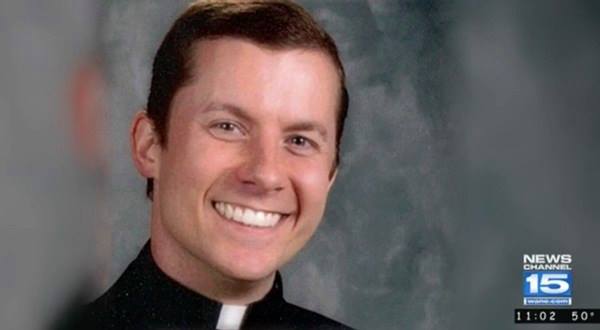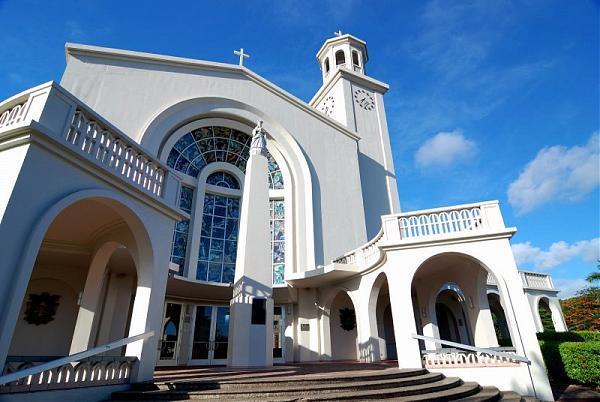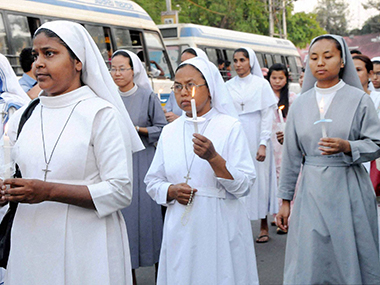By
After a two-day trial and two hours of deliberations, a Meade County jury found Louisville Catholic priest Joseph Hemmerle guilty Tuesday of one count related to sexually molesting a young boy in a summer camp in the 1970s.
Hemmerle, 74, a former Trinity High School teacher, was convicted on one of two counts of immoral or indecent practices with a child following his 2014 indictment on charges of sex abuse and sodomy.

His accuser, Michael Norris, 53, of Texas, had testified that at Camp Tall Trees near Otter Creek Park in 1973, Hemmerle told him to report to his cabin one night to treat poison ivy. Hemmerle told him to strip and stand on a stool before touching him sexually with his hands and mouth, he said.
After the jury foreman read the verdict after 5 p.m. Tuesday, Norris broke out in tears and sobs as he hugged family members who came out to support him, including his mother and wife. Hemmerle just stared straight ahead.
“I feel vindicated,” Norris said, noting it had been 15 years since he first reported it to the church and police. “That jury had the same evidence that the Catholic church had in 2001.”
Norris alerted the archdiocese and Kentucky State Police in 2001 of the incident, but no charges were brought until another accuser from the camp came forward in 2014. His name hasn’t been made public but that trial is set for next April.
In closing arguments in a case that largely boiled down to Norris’ word against Hemmerle’s, defense attorney David Lambertus tried to paint Norris as an attention-seeker who had concocted the story. He said adult oversight at the camp made his story unlikely.
“He was starved for attention,” he said. “He’s gotten plenty out of this.”
But prosecutors noted that Hemmerle admitted to applying poison ivy lotion to some boys genitals, and said Norris had no motivation other than justice for coming forward after “years of suffering.”
“What does he have to gain from telling his story other than getting to the truth?” said Assistant Commonwealth’s Attorney Jeremy Logsdon.
Camp Tall Trees in Otter Creek Park, run by the Archdiocese of Louisville until 2002. Hemmerle was a director at the camp from 1970 to 2001.
Earlier Tuesday, Lambertus called a half dozen witnesses including former counselors who said children were closely monitored. They weren’t allowed to walk around unaccompanied in the evening except to go to the latrine or an activity. But none had direct knowledge or supervision of Norris.
Those testifying included former Kentucky Lt. Gov. Steve Pence, now an attorney who worked as a counselor at Camp Tall Trees in 1973, the year Norris said the abuse took place.
“Kids were not simply allowed to roam in the evenings,” he said.
Hemmerle, wearing a sweater and eyeglasses, took the stand after 11 a.m. He told the jury that he didn’t have his own cabin, as Norris had contended, but rather had a room in an administration building. He said he sometimes treated boys with poison ivy, including putting medical lotion on their genitals, but in the infirmary and always asking permission first.
“Do you want to put the Calamine lotion on or do you want me to do it,” he said he’d ask them.
He said he didn’t remember Norris. Asked if he did anything improper with Norris, he said, “No. Absolutely not. There is no doubt in my mind at all.”
Logsdon said Norris’ recollection “isn’t stuff you make up,” and said that “even in the 1970s, you’re not going to touch someone else’s kid’s genitals. It’s not appropriate whatsoever.”
Norris did not join the slew of plaintiffs who sued the archdiocese in the early 2000s, alleging sexual abuse by dozens of priests. The archdiocese settled a class action lawsuit with 243 plaintiffs in 2003 for more than $25 million.
David Clohessy, director of SNAP, a support group for victims of clergy abuse, issued a statement praising the men for coming forward and for prosecutors taking on the cases. His groups urged others with information about such abuse to come forward, acknowledging it takes “real courage.”
“Child sex abuse cases are very hard. They’re even harder when defendants are well-educated priests backed by powerful church officials,” he said.
Hemmerle, a native of the California neighborhood who attended the old St. Benedict Catholic Elementary School, taught religion at Trinity after his ordination in 1967, the Courier-Journal reported in 2002. He also coached wrestling and track teams, and directed the now-closed boys’ camp from 1971 until about 2001.
Since 2003, after being allowed to return to the ministry following the first accusation, Hemmerle has served as pastor of Holy Cross and St. Francis of Assisi, both near Loretto, Ky., archdiocese officials said. He was put on leave but said in court he had retired.
In the sentencing phase that came after the verdict, the jury recommended seven years, though prosecutors said a single count could carry as many as 10 years in prison. Hemmerle was released on bond pending a final sentencing hearing on Feb. 9.
Complete Article HERE!




 Numerous cases have not made it that far. A 2016
Numerous cases have not made it that far. A 2016